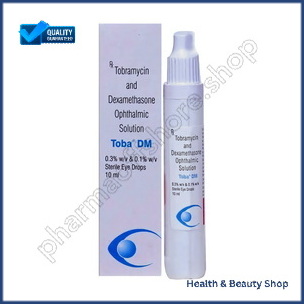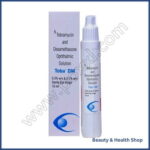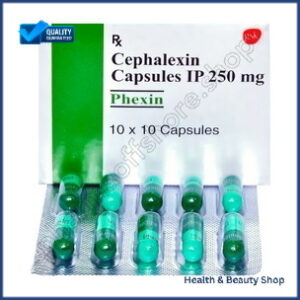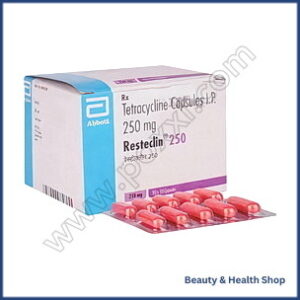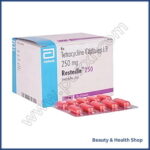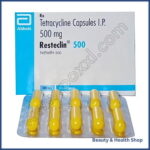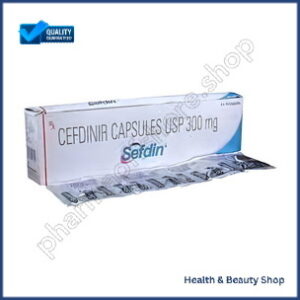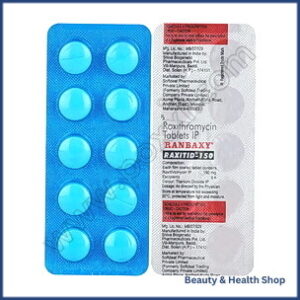ADDICTION
ALCOHOL DEPENDENCE
QUIT SMOKING
ALLERGY
ANTI FUNGAL
FUNGAL INFECTION
FUNGAL NAIL INFECTIONS
ANTI-REJECTION DRUGS
ANTI WORM
ANTIBIOTIC
BACTERIAL INFECTIONS
ARTHRITIS
GOUT
OSTEOARTHRITIS
RHEUMATOID ARTHRITIS
BLOOD
LOW PLATELET COUNT
THROMBOPHLEBITIS
VARICOSE VEINS
COLON
ANAL FISSURE
PILES
ULCERATIVE COLITIS
DIABETES CARE
DIABETES INSIPIDUS
DIABETES TYPE
DIABETIC FOOT ULCERS
GLUCOSE MONITOR
EYES/EAR CARE
DRY EYES
EYE CARE
EYE EXAMINATION
EYE INFECTION
EYE LASHES
EYE PAIN
GLAUCOMA
OCULAR HYPERTENSION
UVEITIS
FEVER CARE
MALARIA
RHEUMATIC FEVER
TYPHOID FEVER
GASTROINTESTINAL
ACIDITY
CONSTIPATION
CROHN'S DISEASE
DIARRHOEA
GALLBLADDER STONES
INTESTINAL ULCERS
IRRITABLE BOWEL SYNDROME
MOTION SICKNESS
NAUSEA
Toba Dm 10 Ml (Tobramycin/Dexamethasone)
| Active Ingredient (Generic Name): | Tobramycin/Dexamethasone |
|---|---|
| Indication: | Bacterial Infections |
| Manufacturer: | Sun Pharmaceutical Industries Ltd |
| Packaging: | 10 ml in one bottle |
| Strength: | 10ml |
From: $36.00
Consider using Tobra D Eye/Ear Drops for treating bacterial infections and inflammation in your eyes or ears. These drops contain Dexamethasone (0.1% w/w) and Tobramycin (0.3% w/w), effective against Pseudomonas aeruginosa, Staphylococcus aureus, and Escherichia coli. Apply one to two drops every four to six hours, without touching the dropper tip to your eye or ear. Learn how to safely and effectively use Tobra D Eye/Ear Drops for symptom relief and healing.
Main Points
- Tobra D Eye/Ear Drops combine 0.1% Dexamethasone and 0.3% Tobramycin for anti-inflammatory and antibacterial effects.
- Indicated for bacterial conjunctivitis, otitis externa, and post-operative prophylaxis.
- Administer one to two drops into affected eye(s) or ear(s) every 4-6 hours, tilting the head back and pulling down the lower eyelid or outer ear.
- Possible mild discomfort as side effect; severe reactions warrant immediate medical attention. Follow prescribed dosage and inform healthcare provider of current medications.
- Store drops in original packaging in a dry place, away from sunlight and moisture at room temperature; check expiration date before use.
What Is Tobra D Eye/Ear Drops
Tobra D Eye/Ear Drops is a combination antibiotic medication containing tobramycin and dexamethasone. It is used topically to treat bacterial infections and inflammation in the eyes and ears. This medication targets bacterial infections and reduces inflammation, helping to alleviate symptoms such as redness, swelling, and discharge. By following the prescribed directions, Tobra D Eye/Ear Drops can effectively treat infections and promote healing in the eyes and ears.
Active Ingredients and Composition
The combination of tobramycin and dexamethasone in Tobra D Eye/Ear Drops contains the following active ingredients:
- Dexamethasone: 0.1% w/w
- Tobramycin: 0.3% w/w
These ingredients work synergistically to combat bacterial infections and reduce inflammation in the eyes and ears. Dexamethasone, a corticosteroid, alleviates swelling, redness, and itching, while tobramycin, an aminoglycoside antibiotic, targets and eliminates bacteria. This combination makes Tobra D Eye/Ear Drops an effective treatment for bacterial infections in the eyes and ears.
How Tobra D Eye/Ear Drops Work
By reducing swelling and redness, Tobra D Eye/Ear Drops have an anti-inflammatory effect on the affected areas. These drops also possess antibacterial properties that help in fighting bacterial infections that may worsen the condition. Understanding how Tobra D Eye/Ear Drops work can help you see how they target the underlying causes of your eye or ear infection effectively.
Anti-Inflammatory Action
Tobra D Eye/Ear Drops contain dexamethasone, a corticosteroid that reduces inflammation in the eyes and ears. Dexamethasone suppresses the production of inflammatory mediators, chemicals that cause inflammation. When applied, Tobra D Eye/Ear Drops penetrate the affected area, decreasing the activity of these mediators and reducing inflammation. This helps alleviate symptoms like redness, swelling, and discomfort in conditions such as conjunctivitis and otitis externa. The anti-inflammatory action of Tobra D Eye/Ear Drops promotes healing, leading to faster recovery and improved comfort for eye and ear issues.
Antibacterial Properties
When applying Tobra D Eye/Ear Drops, tobramycin is released to target bacterial cells in the affected area. Tobramycin, an aminoglycoside antibiotic, disrupts bacterial protein synthesis, leading to the elimination of the bacteria causing infections in the eye and ear. This mechanism of action inhibits bacterial growth, ultimately resulting in bacterial cell death. Tobra D Eye/Ear Drops’ effectiveness against bacterial infections is attributed to its ability to inhibit protein synthesis, bind to the 30S ribosomal subunit, disrupt cell wall synthesis, interfere with DNA replication, and disrupt bacterial membrane function. These antibacterial properties make Tobra D Eye/Ear Drops a reliable treatment for bacterial infections of the eye and ear.
Mechanism of Action
Tobra D Eye/Ear Drops combine tobramycin and dexamethasone to treat bacterial infections and reduce inflammation in the eye and ear. Tobramycin inhibits bacterial protein synthesis, leading to bacterial death, especially against Pseudomonas aeruginosa, Staphylococcus aureus, and Escherichia coli. Dexamethasone, a corticosteroid, reduces inflammation by suppressing inflammatory chemical production, alleviating swelling, redness, and pain. The synergistic effect of tobramycin and dexamethasone in Tobra D Eye/Ear Drops efficiently targets bacterial infections and inflammation in the eye and ear, making it a reliable treatment option for conditions like conjunctivitis and otitis externa.
Uses and Indications of Tobra D
This antibiotic and steroid combination is commonly prescribed to treat bacterial infections of the eye and ear, such as conjunctivitis and otitis externa, accompanied by inflammation. Tobra D effectively fights infections causing redness, swelling, and discharge in the eyes or ears.
Specific uses and indications for Tobra D include:
- Conjunctivitis: Tobra D treats bacterial conjunctivitis, an eye infection leading to redness, itching, and discharge.
- Otitis externa: Prescribed for otitis externa, an infection of the outer ear canal causing pain, itching, and discharge.
- Post-operative care: Tobra D may be used post eye or ear surgery to prevent infection and reduce inflammation.
Benefits of Using Tobra D Drops
When using Tobra D drops, you can experience reduced eye inflammation due to their anti-inflammatory properties. These drops effectively combat bacterial infections and alleviate eye irritation, promoting clearer and healthier vision.
Reduces Eye Inflammation
By reducing inflammation in the eyes, you can experience a decrease in redness, swelling, and discomfort, leading to clearer and more comfortable vision. This is crucial for managing conditions like uveitis or conjunctivitis. Tobra D Eye/Ear Drops, known for their anti-inflammatory properties, offer relief by addressing these symptoms effectively.
Here are three benefits of using Tobra D Drops for eye inflammation:
- Reduction in redness and swelling: Decreasing inflammation helps alleviate bloodshot eyes and improves visual comfort.
- Improved visual acuity: Managing inflammation can restore normal vision, enhancing clarity.
- Enhanced eye health: By reducing inflammation, these drops help prevent potential eye damage and support overall ocular wellness.
Combats Bacterial Infections
Combat bacterial infections in your eyes and ears effectively with Tobra D Eye/Ear Drops. These drops contain the antibiotic tobramycin, which targets and eliminates harmful bacteria like Pseudomonas aeruginosa, Escherichia coli, and Staphylococcus aureus. Tobra D Drops are suitable for treating bacterial conjunctivitis, blepharitis, and other eye infections. They can also be used for bacterial infections of the ear canal, such as otitis externa. The drops penetrate tissues deeply, ensuring the antibiotics reach the infection site to reduce symptoms and promote healing. Trust Tobra D Drops for a powerful solution against bacterial infections in your eyes and ears.
Soothes Eye Irritation
Tobra D Eye/Ear Drops provide fast relief from eye irritation caused by bacterial infections, reducing discomfort and inflammation for quicker recovery and improved vision. These drops effectively alleviate itchy, red, and watery eyes associated with bacterial infections. The dexamethasone in Tobra D Drops reduces swelling and inflammation, while the combination of dexamethasone and tobramycin calms itching and burning sensations in the eyes. By combating infections and inflammation, Tobra D Drops support clear vision, allowing for improved focus on daily activities.
Side Effects and Precautions
When using Tobra D Eye/Ear Drops, be aware of potential side effects ranging from mild discomfort to more serious issues. Common effects may include temporary eye redness, itching, or burning sensations. Should you experience severe eye pain, vision changes, or heightened light sensitivity, seek immediate medical attention.
Adhere strictly to the prescribed dosage and administration instructions to reduce the risk of adverse reactions. Inform your healthcare provider about any current medications to prevent possible interactions. Note that Tobra D Eye/Ear Drops may not be suitable for individuals with specific conditions like glaucoma, cataracts, or perforated eardrums.
To ensure safe application, prevent contamination by refraining from touching the dropper tip to your eye or any surface. If you wear contact lenses, remove them before using the drops and wait at least 15 minutes before reinserting them. By understanding these potential effects and taking necessary precautions, you can use Tobra D Eye/Ear Drops safely and effectively.
Dosage and Administration Guide
Adhere to the provided instructions and your healthcare provider’s advice for the correct administration of Tobra D Eye/Ear Drops. Typically, apply one to two drops into the affected eye(s) or ear(s) every four to six hours as necessary. This will ensure proper and safe usage of the medication.
During application:
- Tilt your head back and pull down the lower eyelid to form a pocket for the eye drops.
- Gently pull back and up on the outer ear to straighten the ear canal before applying the drops.
- Avoid contact between the dropper tip and your eye or ear to prevent contamination.
Remember to wash your hands thoroughly before and after using the drops. If uncertain about the process or have inquiries, seek guidance from your healthcare provider. Always adhere to the prescribed dosage and administration schedule for optimal treatment outcomes.
Storage and Handling Instructions
Store Tobra D Eye/Ear Drops in the original packaging in a dry place away from sunlight and moisture to maintain efficacy. Avoid temperature fluctuations and keep them at room temperature (15?C to 30?C). Store out of reach of children and pets. Check the expiration date before use and discard any expired or contaminated drops. Keep hands clean and dry when handling the drops. For specific guidance on storage and handling, consult a pharmacist or healthcare professional.
Contraindications and Interactions
Tobra D Eye/Ear Drops should not be used by individuals with a known hypersensitivity to any of the active ingredients or excipients. Caution is advised when combining Tobra D with other medications, particularly those affecting the eye or ear.
Potential interactions to consider include:
- Corticosteroids: Combining Tobra D with corticosteroids may heighten the risk of adverse effects like glaucoma or cataract formation.
- Aminoglycosides: Concurrent use of Tobra D with other aminoglycosides may increase the chances of ototoxicity or nephrotoxicity.
- Topical anesthetics: The use of Tobra D with topical anesthetics could elevate the risk of corneal ulcers or other complications.
Inform your healthcare provider about all current medications, including eye or ear drops, to minimize the likelihood of interactions. Your doctor may adjust the dosage or suggest alternative treatments to ensure the safe and effective use of Tobra D Eye/Ear Drops.
Overdose and Missed Dose Information
In case of accidental overdose, rinse the affected eye or ear with water and seek immediate medical attention to reduce potential harm. If you have overdosed on Tobra D Eye/Ear Drops, act promptly. Flush the affected area with water to remove excess medication and seek medical help without delay. Symptoms of overdose may include heightened light sensitivity, blurred vision, and eye pain. If you experience these symptoms, seek medical attention promptly.
If you miss a dose of Tobra D Eye/Ear Drops, administer the missed dose as soon as you remember, unless it is close to your next scheduled dose. If this is the case, skip the missed dose and continue with your regular dosing. Avoid doubling up on doses to compensate for the missed one, as this can increase the risk of overdose. Always adhere to the dosage instructions from your healthcare provider or pharmacist, and if you have any doubts, seek guidance from a medical professional.
Buying and Storing Tobra D Safely
When purchasing Tobra D Eye/Ear Drops, ensure you buy from a licensed pharmacy or reputable online retailer to ensure authenticity and safety. This ensures you receive a genuine product meeting quality standards.
After acquiring your Tobra D Eye/Ear Drops, store them properly to maintain potency and shelf life. Follow these storage tips:
- Keep at room temperature: Store away from direct sunlight, moisture, and extreme temperatures.
- Tighten the cap: Close the cap tightly after use to prevent contamination and evaporation.
- Check the expiration date: Always verify the expiration date before using the drops, and discard if expired.
Frequently Asked Questions
Can I Use Tobra D Drops for Viral Infections Like Conjunctivitis?
Tobra D drops, containing tobramycin and dexamethasone, are not effective against viral infections like conjunctivitis. Tobramycin is an antibiotic that works against bacterial infections, while dexamethasone helps reduce inflammation but does not treat the viral infection itself. For viral conjunctivitis, antiviral medication or supportive care is typically recommended. Consult a healthcare professional for guidance on appropriate treatment options.
Are Tobra D Drops Safe for Use in Children Under 3 Years Old?
When considering the use of Tobra D drops for children under 3 years old, caution is advised. Consult a pediatrician before administering these drops, as they contain dexamethasone, a steroid, and tobramycin, an antibiotic. The safety of these drops in infants and toddlers has not been extensively researched. Possible side effects may include an increased risk of infection, allergic reactions, or delayed healing. A healthcare provider can help assess the benefits and risks and suggest alternative treatments if necessary.
Can I Drive or Operate Heavy Machinery After Using Tobra D Drops?
When using Tobra D drops, you may wonder about driving or operating heavy machinery. Typically, these eye/ear drops do not cause sedation. However, if you encounter blurred vision, dizziness, or other side effects, it is advisable to refrain from driving or using heavy machinery until these effects subside. Prioritize safety for yourself and others by being cautious in such situations.
How Long Does It Take to See the Effects of Tobra D Drops?
When using Tobra D drops, you may notice effects within a few hours. Dexamethasone, a corticosteroid, typically takes 2-4 hours to reduce inflammation, while tobramycin, an antibiotic, begins fighting bacterial infections within 1-2 hours. Relief from symptoms like itching, redness, and swelling can be experienced within 24 hours. Completing the full treatment course as prescribed is crucial for complete clearance of the infection.
Can I Use Tobra D Drops for Eye Injuries or Surgical Wounds?
When addressing eye injuries or surgical wounds, the use of Tobra D drops may be considered for post-operative inflammation and bacterial infections. However, in cases of traumatic eye injuries, it is essential to consult a healthcare professional before applying Tobra D. The severity of the injury needs to be evaluated by a medical professional to determine the most appropriate treatment. Avoid self-medicating, as improper usage could potentially exacerbate the condition.
Conclusion
Tobra D Eye/Ear Drops offers effective treatment for eye and ear infections by combining dexamethasone and tobramycin. This medication is known for its potent antibacterial and anti-inflammatory properties, providing quick relief from discomfort and promoting healing. It is important to adhere to the prescribed dosage, store the drops correctly, and consult a healthcare professional if you have any concerns.

